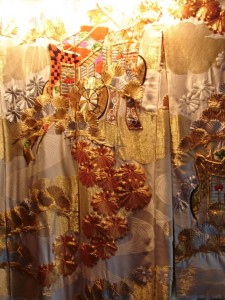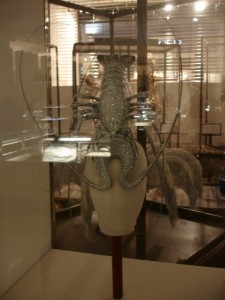To Yohji Yamamoto, the dress maker, failure is important. ‘Failure makes strong motivation for next collection.’
Yamamoto speaks good English, but not perfect English, hence the sentence above being incorrect grammatically.
Yamamoto believes that if he believes a collection is a success, then that is not good (the contrary nature of the man surfaces). If this happens, then he believes he has lost his way ‘and you need to come back to yourself for a long time.’
Yamamoto reckons ‘we need education about beauty.’
BDW
 The talk was good, so I have added some more nuggets of the ‘in conversation’ I heard between Frances Corner and Yohji Yamamoto at the V and A.
The talk was good, so I have added some more nuggets of the ‘in conversation’ I heard between Frances Corner and Yohji Yamamoto at the V and A.
More thoughts from Yamamoto on fast fashion: he is all about designing clothes now that can be worn with clothes from past collections (you can see the timeless quality emerging).
Yamamoto has an innate belief in fabric, and listening to what the fabric has to say.
Tailoring, to Yamamoto, is craftsmanship.
Yamamoto believes in the ‘life button’: the button that is central to a jacket/garment, the button that the garment literally hangs from.
Yamamoto has a thing about sleeves. The human body dictates that the sleeve hole needs to angle forward, to follow the natural fall of the arm.
Yamamoto also has a thing about pockets on breasts, particularly women’s breasts. You can place a pocket high on the mountain, you can place a pocket at the foot of the mountain, but to place a pocket on the mountain is not really his thing.
BDW
Some more notes on an event I went to at the Victoria and Albert Museum: Professor Frances Corner in conversation with Yohji Yamamoto.
Photographers like August Sander and Irving Penn, especially their images of people in everyday working clothes, have influenced Yamamoto greatly. What appeals to him most are the clothes that are a functional statement, related to the body.
Often, Yamamoto chooses to hide the body, make it into a house, a house made of cloth. Then, the imagination gets to work and tries to work out what is inside the house. That, to Yamamoto, is sexier than letting it all hang out.
Yamamoto is aware that he is probably a very contrary character. Whatever is considered appropriate, polite, on trend, he runs away from. ‘I am a very twisted man!’
Yamamoto has this to say on fast fashion: ‘I am praying – don’t waste clothes.’
BDW
 I went to the Victoria and Albert Museum recently to listen to Professor Frances Corner interview Yohji Yamamoto, the Japanese ‘dress maker’ as he calls himself.
I went to the Victoria and Albert Museum recently to listen to Professor Frances Corner interview Yohji Yamamoto, the Japanese ‘dress maker’ as he calls himself.
Some notes on what I heard follow.
For Yamamoto, working in a studio with his assistants are his happiest moments.
He hates fashion. Most specifically, Yamamoto hates the ideas of trends influencing our choice of clothing. To Yamamoto, fashion is about air, and air moves and influences people. Yamamoto runs from this.
He is aiming to achieve timelessness in his design.
Yamamoto always thought/thinks that he is working in a totally international manner, such was, and is the influence on his work of designers like Coco Chanel, Elsa Schiaparelli, Christóbal Balenciaga. Like them, Yamamoto works hard to get the cut right. Tailoring is a big influence.
Yamamoto works so hard to get the cut right that he often forgets to imbue colour in his designs. Anyway, colour can be disturbing to his vision of the garment. If he uses colour, he uses pure, undiluted colour.
BDW
 De-installing Washed Up at Selfridges the other night, I was tasked with the job of moving Philip Treacy’s silver Lobster hat he created for Lady Gaga from a display cabinet in the exhibition to one of the windows facing the street.
De-installing Washed Up at Selfridges the other night, I was tasked with the job of moving Philip Treacy’s silver Lobster hat he created for Lady Gaga from a display cabinet in the exhibition to one of the windows facing the street.
Fantastical, surreal objects as fashion are evocative and tantalising, drawing out reactions and ideas that may not appear again, but which surprise, delight, or dismay. They sit alongside other objects, each juxtaposing the other, challenging perceived preconceptions. Evocative objects are needed so that we can reiterate the famous line – the shock of the new. Be that a completely new idea, or juxtaposition of ideas.
Isn’t that what fashion is about: to challenge, to push forward, to renew relentlessly.
That is, if you like fashion.
BDW
Unpicking something is always an interesting experience. If you may remember, I had to get the help of the obsessive knitter (#4 – A Good Ribbing) to unpick some mittens I was rushing to finish on time awhile back (moral to this story: knitting is not going to grow miraculously longer just because you have somewhere else to be).
Which got me thinking about unravelling, as I was de-installing Washed Up, the exhibition at Selfridges in the heart of London, last weekend. Another overnight adventure (we finished at 6.30am), it always amazes me (even though it shouldn’t as I have done it enough times) how quickly something can be unpicked, pulled apart, re-made, renewed, re-thought through.
Perhaps it was the tiredness that confused my internal body clock and hazy mind. Who knows, but the thought remained: once unpicked, it will never be the same again, but that only invites new opportunities and possibilities for the future.
BDW


